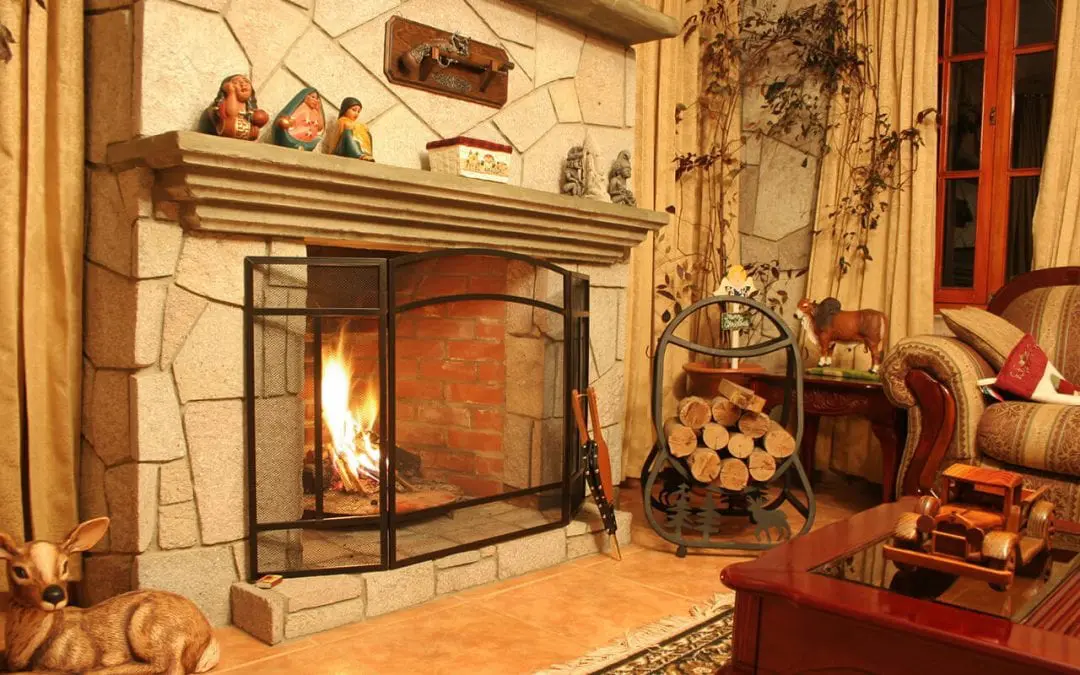Once the weather turns cold, people are eager to start the first fire of the season in their fireplaces. Before starting your first fire of the year, you need to know how to keep your fireplace safe. Follow the ten tips below for before, during, and after your fire to protect your home from damage and your family from injuries.
Get Your Chimney Professionally Cleaned to Keep Your Fireplace Safe
When wood is burning in a fireplace, a material called creosote builds up along the walls of the chimney. Not only can a chimney with too much creosote buildup block smoke from escaping, but creosote can ignite and burn if it comes into contact with flames.
Although there are special logs you can purchase to reduce creosote buildup, hiring a professional chimney sweep every year to clean your chimney is the safest option to keep your fireplace safe.
Put a Cap on Your Chimney
While not all chimneys have a cap on them, caps are a good way to keep your chimney chute unobstructed. A cap is a mesh guard with a metal top that is installed on top of your chimney. It allows smoke to exit and prevents branches, animals, rain, and debris from entering the chute.
Keep Your Fireplace Safe With a Working Damper
Help keep your fireplace safe by checking the damper and flue. Move the damper a few times to make sure it still works and check the flue with a flashlight to see that it is open before lighting.
Check Your Smoke and Carbon Monoxide Detectors
Any home should have the right amount of working smoke detectors, but especially if your home has an active fireplace. Test all your smoke detectors and CO detectors and change the batteries every 6 months.
Burning wood also gives off carbon monoxide, a dangerous and odorless gas that can be deadly if it builds up in your home. If your chimney is open, cleaned, and maintained, you should be safe from carbon monoxide. However, every home should still have at least one working carbon monoxide detector.
Trim Tree Limbs
If it is safe for you to do so, check the area around the top of the chimney for any tree limbs that overhang it. These branches can ignite from the heat or sparks caused by the fire and also block any escaping smoke. Trim back overhanging limbs or hire a professional to complete this task if you don’t feel comfortable.
Add a Fireplace Guard
Hot embers often jump from even the smallest fires. A single spark from a fireplace could potentially reach carpet, curtains, furniture, or clothing and catch it on fire. To safeguard against this, A simple glass or mesh fireplace guard can keep your fireplace safe for people sitting around it.
Light the Right Wood to Keep Your Fireplace Safe
If you are burning natural wood, it should be cut and stored properly for the best fire. The best firewood should be split and have been kept dry for at least six months. Various species of wood burns differently. Avoid green and softwood like pine as it creates more creosote buildup.
Never Leave the Fire Unattended
A lit fireplace should never be left unattended. It only takes one second for a spark to cause an accident to happen. Always have someone in the room. Keep a safe distance from the fireplace and never fall asleep or leave your home while your fire is still lit.
Extinguish the Fire
It might seem like the fire is completely out, but ashes and coals can remain hot for up to three days. Double-check to make sure all flames are out and all hot coals or embers are extinguished.
Properly Dispose of Ashes
A little ash left in the fireplace is not a bad thing. However, if it is left to build up over one inch, it makes it harder to start a fire. Use your fireplace tools to brush any large piles of ash after they have cooled. Collect the ashes in a metal tin and dump them in the compost.
Precision Home Inspectors provides inspection services to Hampton Roads in Virginia. Contact us to book an appointment.

